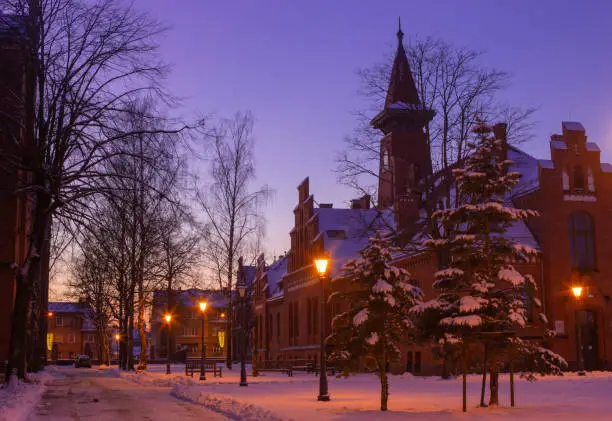Christmas Movie Snow: Is it Movie Magic or Just Simple Science?
At some point, while you’re binging your way through Christmas movies, you’re bound to wonder about that snow. Is it natural? Why doesn’t it melt off the actor’s coats and eyelashes? Then you see that tree with all of its green, healthy leaves rustling in the background. Here we are discussing the Christmas Movie Snow: Is it Movie Magic or Just Simple Science?
Clearly, that’s not natural snow. There’s no way that the leaves on that tree could avoid the shock of prolonged cold with that amount of snow. If it were real, those leaves would be long gone.
Or is it all added after the movie is in post-production? I can’t be the only one who’s been unenchanted by the computerized fake snow dominating the new Christmas movies over on the Hallmark channel.
This blog post is dedicated to those wonderfully curious minds that just want to understand how Hollywood snow works. Maybe grab a warm sweater and a cup of something hot for this ride.
Old School Snow
If you know anything about movies, then you know that their humble beginnings didn’t have sound. You may also know that special effects we’re really a thing yet. So how was “snow” made about a hundred years ago in movies?
Some of these items might make you cringe. Bleached cornflakes. Salt. Gypsum. Concrete dust. Chicken feathers. And asbestos.

While the horrible effects that can come with working with some of these materials weren’t fully known at the time, there were signs. Many cast and crew members would wear masks between takes to help combat difficult breathing around some of the substances.
While those snow substitutes are pretty wild, the filmmakers also used cotton to mimic snow on sets. Unfortunately, cotton underneath the very hot lights on a movie set poses quite a fire hazard.
Big Problems
Let’s all agree that the biggest problem with some of the materials used in early films was the health risks that came with them. No one should be breathing in any of that bad stuff.
But filmmakers found a bunch of other problems with early developed fake snow. For example, a bleached cornflake won’t melt when it lands on someone.
And once you had sound in films, those cornflakes became less desirable for several reasons. The sound of cornflakes crunching underfoot does not sound like the muffled, soft crunch of a boot in the snow.
You can’t leave footprints or even tire tracks in bleached cornflakes (typing “bleached cornflakes” will never feel normal). The realism that filmmakers were looking for just wasn’t there.
The First Known Snowmaker is Invented
Warner Brothers studio needed better snow, so one of their technical directors, Lous Geib, created the first known snowmaking machine. This creation was way back during the 1930s, so it was cutting edge for its time.

The snow machine used huge blades that would rotate while shaving pieces off of a 400-pound hunk of ice. This invention became an essential part of entertainment in Los Angeles. One was even used at the Los Angeles Memorial Coliseum to have ski competitions!
The Next Fail
Towards the end of the 1930s, movie-making studios started building refrigerated sound stages so that the fake snow couldn’t melt so fast anymore. With a high temperature of 25F, you can imagine that there might have been a problem or two.
Cameras back then weren’t designed to do much more than record and they certainly couldn’t withstand such extreme temperatures. Filmmakers had to use blankets and lubricants to try and keep the cameras from freezing.
Since the icy environment proved to be problematic, some films were edited with snow-like images inserted into them. Creative shots, white plaster moulds, and even footage from other films were placed into a movie to give the effect the director wanted.
It’s a Wonderful… Recipe?
It doesn’t matter if you love or hate the classic movie, It’s a Wonderful Life. This is about the snow.
The movie’s director didn’t want to mess around, copying and pasting snow-like objects in his movie. So he went to the special effects department to have them try and whip up some realistic-looking snow that also performed like real snow.
Some soap flakes, water, sugar, and foaming (typically used in fire extinguishers) later and the snow started falling. Well, the snow started falling with the help of high-pressured canons and huge fans. The new snow recipe was so good, that it could be directed by fan adjustments.
While the director used some of the aforementioned materials for different scenes, the new recipe took hold of Hollywood.
While there would be other attempts to create realistic snow, the recipe for It’s a Wonderful Life became the preferred snow for decades in Hollywood.
Snowing to the ‘80s
Can you believe that it took until the 1980s to come up with snow that rivalled the one from so long ago? The new concoction was named “Snowcel” and it’s made from tiny pieces of paper.
This kind of snow has that soft, natural descent to the ground which is why you can see that it was used in the Harry Potter movies. Snow is magical and those movies certainly needed to bring as much magic to the screen as they could.
Snow Snob
Here’s the part that made me want to know about the evolution of snow in Christmas movies. I’ve been enjoying 1 or 2 (or 50) Hallmark Christmas movies and I’ve noticed some pretty unrealistic-looking snowflakes in them. They’re clearly computer-generated flakes.
None of the flakes land on the actors with this type of snow. It kind of seems like we’re back in the territory of bleached cornflakes, but without the nasty chemicals and crunch.
But, as I learned about the refrigerant that Hallmark had to use to keep their snow fresh, realistic, and believable, I do feel as though the computerized snowflakes are the most environmentally friendly choice out there.
So computer-generated flakes are where we stand at this point. Since we’re becoming more aware of our impact on the world, let’s pay attention to our surroundings.
Snow falling in front of trees that are clearly in summer bloom doesn’t make sense. As long as you’ve got that computer up and running, maybe take out the signs of summer during the most wonderful time of the year.
- Facebook0
- Twitter2
- Pinterest4
- LinkedIn2
- 8 shares





